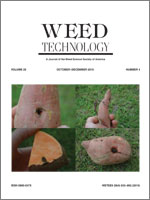Herbicide-resistant Amaranthus spp. continue to cause management difficulties in soybean. New soybean technologies under development, including resistance to various combinations of glyphosate, glufosinate, dicamba, 2,4-D, isoxaflutole, and mesotrione, will make possible the use of additional herbicide sites of action in soybean than is currently available. When this research was conducted, these soybean traits were still regulated and testing herbicide programs with the appropriate soybean genetics in a single experiment was not feasible. Therefore, the effectiveness of various herbicide programs (PRE herbicides followed by POST herbicides) was evaluated in bare-ground experiments on glyphosate-resistant Palmer amaranth and glyphosate-resistant waterhemp (both tall and common) at locations in Arkansas, Illinois, Indiana, Missouri, Nebraska, and Tennessee. Twenty-five herbicide programs were evaluated; 5 of which were PRE herbicides only, 10 were PRE herbicides followed by POST herbicides 3 to 4 wks after (WA) the PRE application (EPOST), and 10 were PRE herbicides followed by POST herbicides 6 to 7 WA the PRE application (LPOST). Programs with EPOST herbicides provided 94% or greater control of Palmer amaranth and waterhemp at 3 to 4 WA the EPOST. Overall, programs with LPOST herbicides resulted in a period of weed emergence in which weeds would typically compete with a crop. Weeds were not completely controlled with the LPOST herbicides because weed sizes were larger (≥ 15 cm) compared with their sizes at the EPOST application (≤ 7 cm). Most programs with LPOST herbicides provided 80 to 95% control at 3 to 4 WA applied LPOST. Based on an orthogonal contrast, using a synthetic-auxin herbicide LPOST improves control of Palmer amaranth and waterhemp over programs not containing a synthetic-auxin LPOST. These results show herbicides that can be used in soybean and that contain auxinic- or HPPD-resistant traits will provide growers with an opportunity for better control of glyphosate-resistant Palmer amaranth and waterhemp over a wide range of geographies and environments.
Nomenclature: 2,4-D; dicamba; glufosinate; glyphosate; HPPD, 4-hydroxyphenylpyruvate dioxygenase; isoxaflutole; and mesotrione; Palmer amaranth, Amaranthus palmeri S. Wats; waterhemp (tall and common, respectively), Amaranthus tuberculatus (Moq.) Sauer, and Amaranthus rudis Sauer; soybean, Glycine max (L.) Merr.
Amaranthus spp. resistentes a herbicidas continúan causando problemas de manejo en soja. Nuevas tecnologías para soja que están actualmente en desarrollo y que incluyen resistencia a varias combinaciones de glyphosate, glufosinate, dicamba, 2,4-D, isoxaflutole, y mesotrione, harán posible el uso de sitios de acción que no están actualmente disponibles para uso en soja. Cuando se realizó esta investigación, estas tecnologías estaban todavía bajo regulación y la evaluación de programas de herbicidas con la genética apropiada de soja en un solo experimento no era factible. Por esto, se evaluó la efectividad de varios programas de herbicidas (herbicidas PRE seguidos de herbicidas POST) en experimentos con suelo desnudo en localidades en Arkansas, Illinois, Indiana, Missouri, Nebraska, y Tennessee que tenían Amaranthus palmeri resistente a glyphosate y Amaranthus rudis y Amaranthus tuberculatus resistentes a glyphosate. Se evaluaron 25 programas de herbicidas; 5 de los cuales fueron solamente herbicidas PRE, 10 fueron herbicidas PRE seguidos por herbicidas POST 3 a 4 semanas después (WA) de la aplicación PRE






